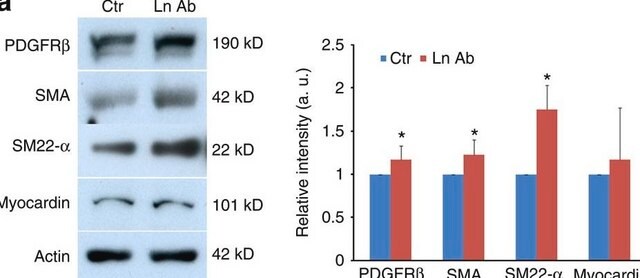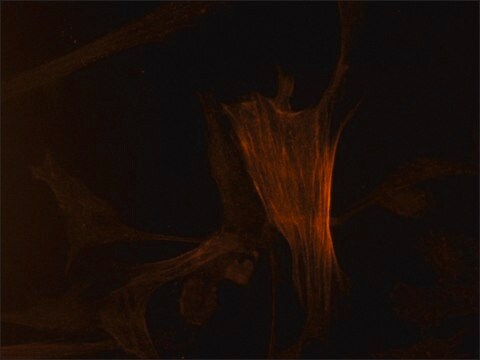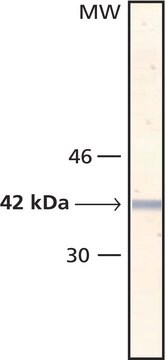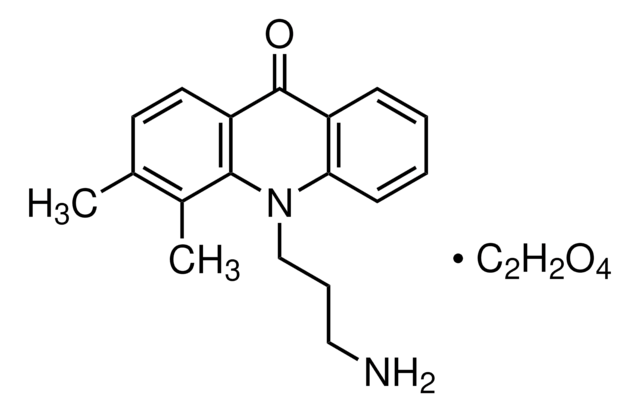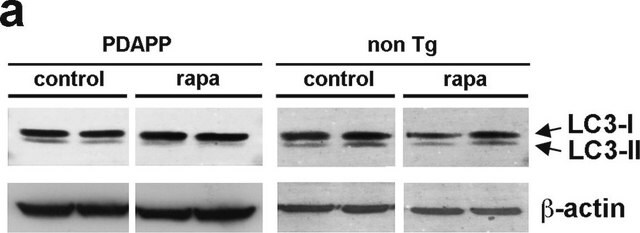Key Documents
F3046
Monoclonal Anti-Actin–FITC antibody produced in mouse
clone AC-40, purified immunoglobulin, buffered aqueous solution
Synonim(y):
Monoclonal Anti-Actin
About This Item
Polecane produkty
pochodzenie biologiczne
mouse
Poziom jakości
białko sprzężone
FITC conjugate
forma przeciwciała
purified immunoglobulin
rodzaj przeciwciała
primary antibodies
klon
AC-40, monoclonal
Postać
buffered aqueous solution
masa cząsteczkowa
antigen 42 kDa
reaktywność gatunkowa
human, Xenopus, hamster, mouse, guinea pig, rat, rabbit, snail, sheep, canine, carp, chicken, pig, bovine, viper, goat
metody
direct immunofluorescence: 1:75 using cultured human or chicken fibroblasts
izotyp
IgG2a
Warunki transportu
dry ice
temp. przechowywania
−20°C
docelowa modyfikacja potranslacyjna
unmodified
informacje o genach
human ... ACTA1(58) , ACTA1(58) , ACTA1(58) , ACTA2(59) , ACTA2(59) , ACTA2(59) , ACTB(60) , ACTB(60) , ACTB(60) , ACTC1(70) , ACTC1(70) , ACTC1(70) , ACTG1(71) , ACTG1(71) , ACTG1(71) , ACTG2(72) , ACTG2(72) , ACTG2(72)
mouse ... Acta1(11459) , Acta1(11459) , Acta1(11459) , Acta2(11475) , Acta2(11475) , Acta2(11475) , Actb(11461) , Actb(11461) , Actb(11461) , Actc1(11464) , Actc1(11464) , Actc1(11464) , Actg1(11465) , Actg1(11465) , Actg1(11465) , Actg2(11468) , Actg2(11468) , Actg2(11468)
rat ... Acta1(29437) , Acta1(29437) , Acta1(29437) , Acta2(81633) , Acta2(81633) , Acta2(81633) , Actb(81822) , Actb(81822) , Actb(81822) , Actc1(29275) , Actc1(29275) , Actc1(29275) , Actg1(287876) , Actg1(287876) , Actg1(287876) , Actg2(25365) , Actg2(25365) , Actg2(25365)
Szukasz podobnych produktów? Odwiedź Przewodnik dotyczący porównywania produktów
Opis ogólny
Immunogen
Zastosowanie
Działania biochem./fizjol.
Postać fizyczna
Inne uwagi
Oświadczenie o zrzeczeniu się odpowiedzialności
Nie możesz znaleźć właściwego produktu?
Wypróbuj nasz Narzędzie selektora produktów.
Kod klasy składowania
12 - Non Combustible Liquids
Klasa zagrożenia wodnego (WGK)
nwg
Temperatura zapłonu (°F)
Not applicable
Temperatura zapłonu (°C)
Not applicable
Certyfikaty analizy (CoA)
Poszukaj Certyfikaty analizy (CoA), wpisując numer partii/serii produktów. Numery serii i partii można znaleźć na etykiecie produktu po słowach „seria” lub „partia”.
Masz już ten produkt?
Dokumenty związane z niedawno zakupionymi produktami zostały zamieszczone w Bibliotece dokumentów.
Nasz zespół naukowców ma doświadczenie we wszystkich obszarach badań, w tym w naukach przyrodniczych, materiałoznawstwie, syntezie chemicznej, chromatografii, analityce i wielu innych dziedzinach.
Skontaktuj się z zespołem ds. pomocy technicznej